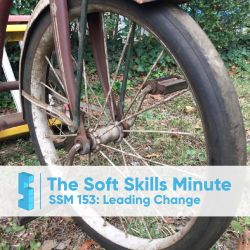Share

Serious Soft Skills
Podcast 8: Soft Skills That Guide Organizational Change, Vision
•
Hosts Dr. Tobin Porterfield and Bob Graham look at the soft skills that guide an organization and its culture toward change and a shared vision.
Bob Graham (‘0:00'): Coming up, we're going to talk about the list of soft skills that play the most prominent role in organizations and organizational change. That and more in just a few seconds.
Introduction
Graham ‘0:20': Welcome to Episode 8 of Serious Soft Skills. I'm Bob Graham and with me as always is Dr. Tobin Porterfield. We each teach college, (not this month, but soon we will be back at it, we're getting close); we collaborate on researching soft skills (boy, do we), and we both have used and seen others employ soft skills over the course of our long and illustrious careers, not that long and not that illustrious. We think our experience and expertise give us a unique lens for looking at soft skills. Let's get to it.
Captaining the Ship
Graham ‘0:55': We talk about organizations big and small needing a leader, someone who can chart the course for how the company is going to evolve. Without leadership, there's no captain to the ship. That's the analogy I like to use. You've got to have a captain. Even if it's a one person company, there's got to be a captain. We both know examples of businesses that are rudderless, that no one is steering, that they are just blowing in the wind. We're going to talk about the soft skills that make captaining of a ship, whether it's a business or an organization, possible. But before we get into that, can you sort of explain where we are? We have been going over these soft skills in groupings we created over the last three or four weeks. I thought you could set it up for us.
Dr. Tobin Porterfield ‘1:43': In our research, we identified over 50 unique skills that make up what we consider that soft skill set. That number certainly is overwhelming, and where do you even start? We took the approach of how do you eat an elephant: One bite at a time. We took that 50+ and broke it into four groups. What will be challenging for us is that we formulated those groups based on where those soft skills are applied in the organization. We first started with Individual soft skills (Episode 5), which include loyalty, time management, things that the person internalizes and brings with them. Then, we moved onto Nexus soft skills (Episode 6), which are those soft skills you use in one-on-one interactions. Then, we expanded out to Group soft skills (Episode 7), which are obviously those special skills you need to operate in an environment with several people or more. Now, here we are with the top group, which we call Enterprise soft skills, because they really separate themselves. What is really challenging about these Enterprise soft skills is that they also apply in other levels, but what makes them distinct and the reason we pulled them into the Enterprise soft skill level was that they can be very clearly applied in a strategic way.
An Example of Enterprise Soft Skills
Porterfield ‘3:10': Let me just give you an example. Being persuasive is one of the soft skills we put at the Enterprise level. Certainly at all levels of communication, we want to persuade people to our thinking, we want to be able to communicate our ideas. So we want to have that influence factor. But that is so much more critical to the leadership level or in a broader sense, when we are influencing the organization.
More episodes
View all episodes

SSM 158: Details, details, details
02:05Tobin Porterfield discusses the soft skill of paying attention to details.
75 Coaching With Neal Woodson Part 1
15:45Bob Graham interviews author, trainer, and expert coach Neal Woodson Part 1
SSM 157: Defaulting
03:11Bob discusses the power of defaulting to YES rather than immediately saying NO
SSM 156: Pivoting
03:02Bob Graham discusses how that you need to know when to alter you agenda. Even what works for years may need to change for long term success.


SSM 153: Leading Change
03:08If you are ready for a change - you might have to lead it - on today's podcast
